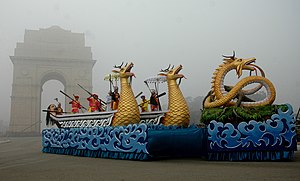Korouhanba
| Korouhanba (Old Manipuri: Kolouhanpa) | |
|---|---|
 Sun God Korouhanba | |
| Other names | Kolouhanpa, Numit, Taohuireng, Taodanba, Ngantureng |
| Affiliation | Meitei mythology (Manipuri mythology) and Meitei religion (Sanamahism) |
| Major cult center | Moidangpok |
| Abode | Heaven |
| Symbol | Sun |
| Day | Sunday |
| Texts | Numit Kappa, Soupon Lailemma Loutalon, Wakoklon Heelel Thilen Salai Amailon Pukok Puya |
| Gender | Male |
| Region | Ancient Kangleipak (Antique Manipur) |
| Ethnic group | Meitei ethnicity |
| Festivals | Lai Haraoba |
| Equivalents | |
| Greek equivalent | Helios, Apollo |
| Roman equivalent | Sol |
| Hinduism equivalent | Surya |
| Egyptian equivalent | Ra |
Korouhanba (Meitei: ꯀꯣꯔꯧꯍꯟꯕ, Old Manipuri: ꯀꯣꯂꯧꯍꯟꯄ, romanized: ko-lou-han-pa, lit. 'Master of the Sky') is the God of the Sun, the Sky and the Heaven in Meitei mythology and religion of Ancient Kangleipak (Antique Manipur).[1][2][3] He is also known as Taohuireng and is one of the two sun brothers in the Numit Kappa epic legend. For having the ability to remove darkness, he is also called "Ngantureng". He is described as "Songbu Chiraitangba", a physician who is bald headed.[1]
Etymology[change | change source]

The Meitei name "Korouhanba" (ko.rəu.hən.bə, ꯀꯣꯔꯧꯍꯟꯕ) is a term for the Sun. This term is generally used in verses or in poems. "Korouhanba" (ko.rəu.hən.bə, ꯀꯣꯔꯧꯍꯟꯕ) can be fragmented into "Korou" (ko.rəu, ꯀꯣꯔꯧ), "Han" (hən, ꯍꯟ) and "Ba" (bə, ꯕ). "Korou" (ko.rəu, ꯀꯣꯔꯧ) means the day. "Han" (hən, ꯍꯟ) means "to be older". "Ba" (bə, ꯕ) denotes noun form.[4]
Description[change | change source]

According to the Meitei tradition, Sun God Korouhanba has strong connection with human body, human soul and origin of life. The human body is a "Lang" (lit. trap). Inside the trap, the "Thawai Polpi" (lit. soul bird) is kept. The soul bird leaves the former "Lang" and enters into another "Lang". The process is called "Langon" (lit. Changing of Lang). The "Polpilang Puya" text describes that the sun is the origin of life. It was told to Luwang Leikoiba by Mangang Laininghal according to the text. He (the Sun) represents the Supreme Being in the world of things (non living) and beings (living). He is Korouhanba.[5][2][3]
Cults and pantheons[change | change source]
The Lai Haraoba festival is celebrated in honor of God Korouhanba every year. The most significant shrine dedicated to God Korouhanba is in Moidangpok town in Manipur.[6] The cults and pantheons dedicated to God Korouhanba are mainly maintained by the Thokchom family of Meitei ethnicity.[7]
He has religious association with the Maring tribe.[8][9]
Connection with other deities[change | change source]
God Korouhanba has connection with Mangang Luwang Khuman, the three divine teachers in many legends.[1][2][3]
Namesakes[change | change source]
Martial Arts Club[change | change source]
The Ibudhou Korouhanba Thang-Ta Moidangpok is a club of Thang Ta, a martial art form of the Meitei ethnicity. This martial arts association was a leading participant in the 31st State Thang Ta Championship in the year 2021.[10][11]
Related pages[change | change source]
References[change | change source]
- ↑ 1.0 1.1 1.2 1.3 Singh, Moirangthem Kirti (1993). Folk Culture of Manipur. Manas Publications. ISBN 978-81-7049-063-0. Retrieved 11 June 2021.
- ↑ 2.0 2.1 2.2 Kanglei Langba Pakhangba (in Manipuri). 1955. p. 4.
{{cite book}}:|website=ignored (help) - ↑ 3.0 3.1 3.2 Leishemlon Areeba (in Manipuri). 1983. p. 4.
{{cite book}}:|website=ignored (help) - ↑ "Learners' Manipuri-English dictionary.Korouhanba". uchicago.edu. 2006.
- ↑ A Critical Study Of The Religious Philosophy. August 1991. p. 111.
{{cite book}}:|website=ignored (help) - ↑ Cheitharol Kumpapa (Royal Chronicle of Manipur 33 A.D – 1984 A.D) by Brahmacharimayum Kulachandra Sharma (in Manipuri). p. 447.
{{cite book}}:|website=ignored (help) - ↑ Devi, Lairenlakpam Bino (2002). The Lois of Manipur: Andro, Khurkhul, Phayeng and Sekmai. Mittal Publications. ISBN 978-81-7099-849-5. Retrieved 11 June 2021.
- ↑ Ayyappappanikkar, Sahitya Akademi (1997). Medieval Indian Literature: An Anthology. Sahitya Akademi. ISBN 978-8126007882. Retrieved 1 June 2021.
- ↑ MEDIEVAL INDIAN LITERATURE AN ANTHOLOGY VOL. 3. Sahitya Akademi, New Delhi. 1959. p. 391.
{{cite book}}:|website=ignored (help) - ↑ "Ibudhou Korouhanba Thang-Ta Moidangpok leading with 15 gold". e-pao.net.
- ↑ "Thang-Ta Maheikol, Yumnam Huidrom take home team champions title of 31st State Thang-Ta C'ship 2021". e-pao.net.
Bibliography[change | change source]
- A Critical Study Of The Religious Philosophy - by Singh, L. Bhagyachandra - 1991

